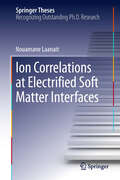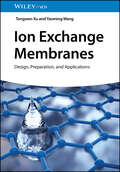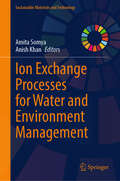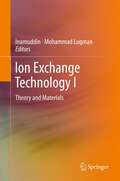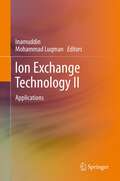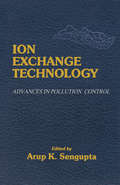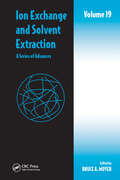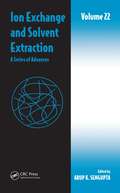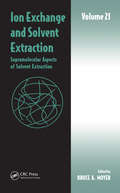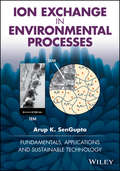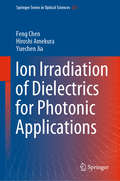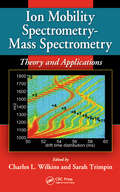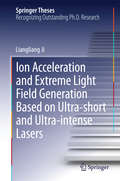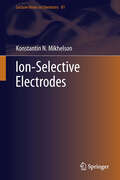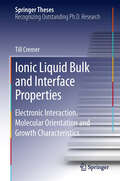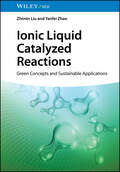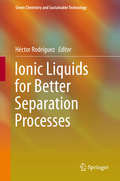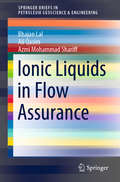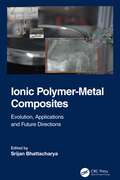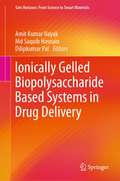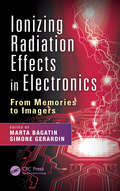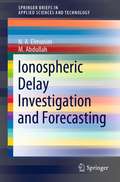- Table View
- List View
Ion Correlations at Electrified Soft Matter Interfaces
by Nouamane LaanaitIon Correlations at Electrified Soft Matter Interfaces presents an investigation that combines experiments, theory, and computer simulations to demonstrate that the interdependency between ion correlations and other ion interactions in solution can explain the distribution of ions near an electrified liquid/liquid interface. The properties of this interface are exploited to vary the coupling strength of ion-ion correlations from weak to strong while monitoring their influence on ion distributions at the nanometer scale with X-ray reflectivity and on the macroscopic scale with interfacial tension measurements. This thesis demonstrates that a parameter-free density functional theory that includes ion-ion correlations and ion-solvent interactions is in agreement with the data over the entire range of experimentally tunable correlation coupling strengths. The reported findings represent a significant advance towards understanding the nature and role of ion correlations in charged soft-matter. Ion distributions underlie many scientific phenomena and technological applications, including electrostatic interactions between charged biomolecules and the efficiency of energy storage devices. These distributions are determined by interactions dictated by the chemical properties of the ions and their environment, as well as the long-range nature of the electrostatic force. The presence of strong correlations between ions is responsible for counterintuitive effects such as like-charge attraction.
Ion Exchange Membranes: Design, Preparation, and Applications
by Tongwen Xu Yaoming WangIon Exchange Membranes A comprehensive introduction to the electro-membrane technologies of the future An ion exchange membrane is a polymer-based membrane which can be permeable by some ions in a solution while blocking others, making them ideal for processes such as water desalination, salt concentration control, clean production and—given their electrical conductivity—power generation and energy storage etc. Recent advances have given rise to new electro-membrane processes that promise drastically to expand the applications of this technology. Scientists in both research and industry will increasingly need to draw on these membranes in vital ways with strongly positive potential environmental impact. Ion Exchange Membranes summarizes recent research into these membranes and electro-membrane processes before moving to an overview of the historical background. It then attends in detail to cutting-edge fabrication technologies and the most recent areas of use. The result is a comprehensive introduction to the design, fabrication, and applications of these increasingly essential membranes. Ion Exchange Membranes readers will also find: In-depth treatment of industrial-scale applications Detailed discussion of topics including side-chain engineering, polyacylation, superacid-catalyst polymerization, and more Analysis of electro-membrane processes such as alkaline membrane water electrolysis, solar-driven water splitting, and many more Ion Exchange Membranes is ideal for membrane scientists, materials scientists, inorganic chemists, polymer chemists, and researchers and engineers in a variety of fields working with ion exchange membranes and electro-membrane processes.
Ion Exchange Pollution Control: Volume II
by C. CalmonThe aim of these volumes is not to cover all phases of ion-exchange theory, which may be found in general texts, nor to cover every application in the literature, or to show an engineer ways on how to become an expert in the field so he coulddo it all by himself. The main purpose of these books is to show the practical engineer what has been done in various types of applications of ion-exchange processes in pollution control, how to set up laboratory tests, the problems that may be encountered to identify the individuals and organizations who are experts in the various phases of ion exchange, and most importantly, to emphasize the new developments in the polymers with active sites that offer new approaches to wastewater treatment methods.
Ion Exchange Processes for Water and Environment Management (Sustainable Materials and Technology)
by Anish Khan Amita SomyaThis book presents theory, principles and applications of ion exchangers for water and environment management. It begins with an introduction, ion-exchange equilibrium kinetics of ion-exchange process and fundamental properties of ion exchangers which make them appropriate in various applications. The theories underlying the operation of ion-exchange resins are explained, as well as the production of resin products with groups adapted to specific ions or groups of ions including principles of ion-exchange process, different synthetic procedures of ion exchangers and characterization techniques, and the role of ion exchangers with their specific characteristics. This book is an invaluable tool to analytical chemists and researchers who are interested in the applications of ion-exchange materials.
Ion Exchange Technology I
by Mohammad Luqman Inamuddin Dr.Ion-exchange Technology I: Theory and Materials describes the theoretical principles of ion-exchange processes. More specifically, this volume focuses on the synthesis, characterization, and modelling of ion-exchange materials and their associated kinetics and equilibria. This title is a highly valuable source not only to postgraduate students and researchers but also to industrial R&D specialists in chemistry, chemical, and biochemical technology as well as to engineers and industrialists.
Ion Exchange Technology II
by Dr Inamuddin Mohammad LuqmanIon-exchange Technology II: Applications presents an overview of the numerous industrial applications of ion-exchange materials. In particular, this volume focuses on the use of ion-exchange materials in various fields including chemical and biochemical separations, water purification, biomedical science, toxic metal recovery and concentration, waste water treatment, catalysis, alcohol beverage, sugar and milk technologies, pharmaceuticals industry and metallurgical industries. This title is a highly valuable source not only to postgraduate students and researchers but also to industrial R&D specialists in chemistry, chemical, and biochemical technology as well as to engineers and industrialists.
Ion Exchange Technology: Advances in Pollution Control
by Arup K. SenGuptaThis book provides comprehensive coverage of developments in ion exchange areas which would continue to have major impacts in the general pursuit of pollution control and pollution prevention. Its nine chapters can be split into four different theme areas: trace contaminants removals; new materials; desalination and finally controlling gaseous pollutants. This would have value for practicing engineers, scientists and researchers who are pertaining to ion exchange technology. It would also server the needs of those trying to explore and identify new technologies in the areas of pollution control and pollution prevention.
Ion Exchange and Solvent Extraction: A Series of Advances, Volume 19 (Ion Exchange and Solvent Extraction Series)
by Bruíea. MoyerThe growth in the world's nuclear industry, motivated by peaking world oil supplies, concerns about the greenhouse effect, and domestic needs for energy independence, has resulted in a heightened focus on the need for next-generation nuclear fuel-cycle technologies. Ion Exchange and Solvent Extraction: A Series of Advances, Volume 19 provides a com
Ion Exchange and Solvent Extraction: A Series of Advances, Volume 22 (Ion Exchange and Solvent Extraction Series #Vol. 16)
by Arup K. SenguptaSince the Second World War, the field of ion exchange has taken a dominant role in offering solutions to many problems in the developed and developing world. It has evolved to a wide array of applications, including mining, microelectronics, drug delivery and detection, food, fertilizers, chemical cleaning, catalysis, bioseparation, water management, environmental research and practices, and energy. The six chapters in this book represent diverse contributions from researchers around the globe who are making noticeable strides in the field in currently important areas: Brackish water desalination Removing boron from water Sustainable approaches for synthesizing commercially important epoxide building blocks Solid-phase heavy-metal separation Separating concentrated ion mixtures in sorption columns Sensing toxic metals Ion Exchange and Solvent Extraction: A Series of Advances, Volume 22 provides a focused review of new materials and new processes that have developed and are rapidly growing. It describes cutting-edge research and practices in the use of ion exchange for building a cleaner, sustainable world and provides thoughtful insights on what ion exchange may do for us in the future.
Ion Exchange and Solvent Extraction: Volume 21, Supramolecular Aspects of Solvent Extraction
by Bruce A. MoyerOver the past several decades, the theme of supramolecular chemistry (SC) has permeated nearly all aspects of chemical endeavor. Not surprisingly, it has also pervaded the field of solvent extraction (SX), inspiring the framework for this volume of Ion Exchange and Solvent Extraction. In addition, tools for studying aggregation have grown increasin
Ion Exchange in Environmental Processes: Fundamentals, Applications and Sustainable Technology
by Arup K. SenguptaProvides a comprehensive introduction to ion exchange for beginners and in-depth coverage of the latest advances for those already in the field As environmental and energy related regulations have grown, ion exchange has assumed a dominant role in offering solutions to many concurrent problems both in the developed and the developing world. Written by an internationally acknowledged leader in ion exchange research and innovation, Ion Exchange: in Environmental Processes is both a comprehensive introduction to the science behind ion exchange and an expert assessment of the latest ion exchange technologies. Its purpose is to provide a valuable reference and learning tool for virtually anyone working in ion exchange or interested in becoming involved in that incredibly fertile field. Written for beginners as well as those already working the in the field, Dr. SenGupta provides stepwise coverage, advancing from ion exchange fundamentals to trace ion exchange through the emerging area of hybrid ion exchange nanotechnology (or polymeric/inorganic ion exchangers). Other topics covered include ion exchange kinetics, sorption and desorption of metals and ligands, solid-phase and gas-phase ion exchange, and more. Connects state-of-the-art innovations in such a way as to help researchers and process scientists get a clear picture of how ion exchange fundamentals can lead to new applications Covers the design of selective or smart ion exchangers for targeted applications—an area of increasing importance—including solid and gas phase ion exchange processes Provides in-depth discussion on intraparticle diffusion controlled kinetics for selective ion exchange Features a chapter devoted to exciting developments in the areas of hybrid ion exchange nanotechnology or polymeric/inorganic ion exchangers Written for those just entering the field of ion exchange as well as those involved in developing the “next big thing” in ion exchange systems, Ion Exchange in Environmental Processes is a valuable resource for students, process engineers, and chemists working in an array of industries, including mining, microelectronics, pharmaceuticals, energy, and wastewater treatment, to name just a few.
Ion Irradiation of Dielectrics for Photonic Applications (Springer Series in Optical Sciences #231)
by Feng Chen Hiroshi Amekura Yuechen JiaThis book focuses on the fundamentals, technologies and properties of ion irradiation of dielectric materials (e.g. glasses, crystals) with regard to various photonic applications. It introduces readers to diverse ion-beam techniques for the fabrication and modification of micron- or nanoscale photonic structures, including optical waveguides, photonic crystals, and nanoparticle (nano-spheres and nano-rods) systems, and presents state-of-the-art advances in this multi-disciplinary research field, demonstrating the unique capabilities of ion-beam technologies in optical dielectric materials processing. The book discusses in detail the properties of ion-beam processed waveguides, as well as the modification of dielectrics for photonic applications, such as electro-optic modulation, nonlinear frequency conversion, waveguide amplification and lasing. It also explores synthesis and the correlated optical effects of nanoparticles by ion beams, and features examples of successful micro- and nano-photonic devices. Given its breadth of coverage, the book will particularly appeal to readers interested in ion-beam technology, materials science, and integrated optics.
Ion Mobility Spectrometry - Mass Spectrometry: Theory and Applications
by Charles L. Wilkins Sarah TrimpinThe analytical power of ion mobility spectrometry-mass spectrometry (IMS-MS) instruments is poised to advance this technology from research to analytical laboratories. Exploring these developments at this critical juncture, Ion Mobility Spectrometry-Mass Spectrometry: Theory and Applications covers the tools, techniques, and applications involved when molecular size and shape information is combined with the well-known analytical advantages of high-performance mass spectrometry.One of the Most Exciting Developments in Contemporary Mass SpectrometryAfter presenting an overview chapter and the fundamentals, the book focuses on instrumentation and ionization sources. It describes an ion-mobility-capable quadrupole time-of-flight mass spectrometer, the differential mobility analyzer, a cryogenic-temperature ion mobility mass spectrometer, the atmospheric solids analysis probe method, and laserspray ionization. In the final applications-oriented chapters, the contributors explore how homebuilt and commercial instruments using electrospray ionization and matrix-assisted laser desorption/ionization (MALDI) methods are employed to solve biological and synthetic issues.Harness the Power of IMS-MS for Analyzing Complex SubstancesThis work helps readers unfamiliar with IMS-MS to understand its fundamental theory and practical applications. It also encourages them to investigate the potential analytical uses of IMS-MS and further explore the power of this method. Numerous color figures are included on downloadable resources.
Ion acceleration and extreme light field generation based on ultra-short and ultra-intense lasers
by Liangliang JiThis book is dedicated to the relativistic (laser intensity above 1018 W/cm2) laser-plasma interactions, which mainly concerns two important aspects: ion acceleration and extreme-light-field (ELF). Based on the ultra-intense and ultra-short CP lasers, this book proposes a new method that significantly improves the efficiency of heavy-ion acceleration, and deals with the critical thickness issues of light pressure acceleration. More importantly, a series of plasma approaches for producing ELFs, such as the relativistic single-cycle laser pulse, the intense broad-spectrum chirped laser pulse and the ultra-intense isolated attosecond (10-18s) pulse are introduced. This book illustrates that plasma not only affords a tremendous accelerating gradient for ion acceleration but also serves as a novel medium for ELF generation, and hence has the potential of plasma-based optics, which have a great advantage on the light intensity due to the absence of device damage threshold.
Ion-Selective Electrodes
by Konstantin N. MikhelsonIon-selective electrodes (ISEs) have a wide range of applications in clinical, environmental, food and pharmaceutical analysis as well as further uses in chemistry and life sciences. Based on his profound experience as a researcher in ISEs and a course instructor, the author summarizes current knowledge for advanced teaching and training purposes with a particular focus on ionophore-based ISEs. Coverage includes the basics of measuring with ISEs, essential membrane potential theory and a comprehensive overview of the various classes of ion-selective electrodes. The principles of constructing ISEs are outlined, and the transfer of methods into routine analysis is considered. Advanced students, researchers, and practitioners will benefit from this expedient introduction.
Ionic Liquid Bulk and Interface Properties
by Till CremerIn this thesis, Till Cremer investigates the bulk properties of ionic liquids (IL), the IL/vacuum interface and the IL/solid interface. For these studies the author primarily uses angle-resolved X-ray photoelectron spectroscopy under ultrahigh vacuum conditions. ILs represent a class of materials with unique physico-chemical properties. Many applications take advantage of the extremely low vapor pressure of aprotic ILs to fabricate permanent, non-volatile liquid coatings on solid materials. The author focuses on issues related to thin IL coatings, in particular concerning new catalytic concepts such as the supported ionic liquid phase (SILP) and solid catalyst with ionic liquid layer (SCILL) systems. Till Cremer presents a number of fundamental contributions to the new field of "Ionic Liquid Surface and Interface Science". Highlights are his results concerning anion/cation-interactions and the growth of ultrathin layers of ionic liquids on various substrates in the context of supported ionic liquid catalysis. His results have significantly contributed to the present level of understanding in the field and accordingly he is author and coauthor of ten publications on the topic in high-ranked journals.
Ionic Liquid Catalyzed Reactions: Green Concepts and Sustainable Applications
by Zhimin Liu Yanfei ZhaoUnderstand the applications of ionic liquid catalysis with this cutting-edge overview Ionic liquids have distinctive properties that have made them the subject of vigorous research in recent decades. They have primarily been seen as potential green alternatives to volatile organic solvents, and therefore as a vital tool in the development of sustainable industry. In fact, however, ionic liquids can also serve as catalysts, catalyst immobilizers, and initiators, with the result that they have been applied in over 100 known types of chemical reactions. Ionic Liquid Catalyzed Reactions: Green Concepts and Sustainable Applications offers a detailed overview of these reactions and the catalytic mechanism of ionic liquids. It surveys cutting-edge research into ionic liquid catalysis and the concepts, perspectives, and skills needed for scientists to incorporate it into a range of experimental fields. It is a must-own for anyone looking to understand the range and variety of uses for ionic liquid catalysis. Ionic Liquid Catalyzed Reactions readers will also find: Case studies throughout showing ionic liquid catalysis applications Information for scientists working in organic chemistry, electrochemistry, biotechnology, and many more Detailed coverage of reactions including CO2 conversion, biomass transformation, organic synthesis, and many others Ionic Liquid Catalyzed Reactions is ideal for catalytic chemists, organic chemists, environmental chemists, electrochemists, and anyone else working with chemical catalysis in need of new experimental methods.
Ionic Liquids for Better Separation Processes
by Héctor RodríguezThis book discusses capital separation processes of industrial interest and explores the potential for substantial improvement offered by a promising class of substances: ionic liquids. These low melting point salts, with their unique characteristics, have been gaining relevance in the field of separation through a variety of approaches. The chapters are structured from an application perspective, and cover the utilisation of ionic liquids in different unit operation contexts (distillation, liquid-liquid extraction, and solid-liquid extraction), giving an idea of their remarkable versatility. The final chapters focus on the use of ionic liquids in analytical applications based on separation procedures. This volume combines the review of the main advances to date with the analysis of the potential future use of ionic liquids in separation processes across a variety of fields, ranging from enhancement of state-of-the-art technologies to a revolution in the technological bases currently in use. It provides a valuable resource for engineers and scientists working in the field of separation, as well as for all readers generally interested in ionic liquids, in particular from an application standpoint. Héctor Rodríguez is a faculty member of the Department of Chemical Engineering at the University of Santiago de Compostela, Spain.
Ionic Liquids in Flow Assurance (SpringerBriefs in Petroleum Geoscience & Engineering)
by Bhajan Lal Ali Qasim Azmi Mohammad ShariffThis book focuses on the application of ionic liquids in flow assurance in the oil and gas industry. It discusses their physiochemical properties, and considers the role of ionic liquids as gas hydrate inhibitors in offshore pipelines. Gas hydrate occurrence can pose a major threat to pipeline integrity. Therefore, different categories of gas hydrate inhibitors and the main factors influencing ionic liquids during gas hydrate inhibition are examined thoroughly. The use of ionic liquids as corrosion inhibitors, their application in flow assurance industry to mitigate corrosion, and factors affecting their performance are discussed. Finally, the applications of ionic liquids in wax, scale and asphaltenes deposition control is explored. The extensive discussion of ionic liquids in flow assurance mean that this book will be of use to researchers, engineers, and industry professionals in upstream processing of the oil and gas sector.
Ionic Polymer-Metal Composites: Evolution, Application and Future Directions
by Srijan BhattacharyaThis book focuses on electro active polymer material known as Ionic Polymer Metal Composite (IPMC) having unique applicability as sensor and actuator which finds extensive use in various domain of engineering and science research. Apart from fundamentals of the IPMC concept, various applications are covered extensively across the chapters including space, underwater and nanoscale, including manufacturing processes. Dedicated chapters are included for robotics and biomedical applications and possible research gaps. Future research perspectives for IPMC are also discussed. Features: Covers principle of Ionic Polymer Metal Composite (IPMC), manufacturing processes, applications, and future possibilities in a systematic manner Highlights IPMC practical applicability in biomedical engineering domain Explores Single-walled carbon nanotubes (SWNT) based IPMC soft actuators Discusses IPMC applications in underwater areas Includes IPMC application in robotics focusing on special compliant mechanism This book is aimed toward researchers, graduate students and professionals in materials and mechanical engineering, robotics, mechatronics, biomedical engineering, and physics.
Ionically Gelled Biopolysaccharide Based Systems in Drug Delivery (Gels Horizons: From Science to Smart Materials)
by Amit Kumar Nayak Md Saquib Hasnain Dilipkumar PalThis volume provides a thorough insight into the chemistry and mechanism of ionic gelations of various ionic biopolysaccharides, like alginate, gellan gum, pectin, chitosan, carboxymethyl cellulose, etc., and the applications of various ionically gelled biopolysaccharides in drug delivery fields, with chapters emphasizing the recent advances in the field by the experts. This book will be of interest to graduate students and academic and industry researchers from pharmacy, biotechnology, bioengineering, biomedical and material sciences fields.
Ionizing Radiation Effects in Electronics: From Memories to Imagers (Devices, Circuits, and Systems)
by Marta Bagatin Simone GerardinIonizing Radiation Effects in Electronics: From Memories to Imagers delivers comprehensive coverage of the effects of ionizing radiation on state-of-the-art semiconductor devices. The book also offers valuable insight into modern radiation-hardening techniques.The text begins by providing important background information on radiation effects, their underlying mechanisms, and the use of Monte Carlo techniques to simulate radiation transport and the effects of radiation on electronics. The book then: Explains the effects of radiation on digital commercial devices, including microprocessors and volatile and nonvolatile memories—static random-access memories (SRAMs), dynamic random-access memories (DRAMs), and Flash memories Examines issues like soft errors, total dose, and displacement damage, together with hardening-by-design solutions for digital circuits, field-programmable gate arrays (FPGAs), and mixed-analog circuits Explores the effects of radiation on fiber optics and imager devices such as complementary metal-oxide-semiconductor (CMOS) sensors and charge-coupled devices (CCDs) Featuring real-world examples, case studies, extensive references, and contributions from leading experts in industry and academia, Ionizing Radiation Effects in Electronics: From Memories to Imagers is suitable both for newcomers who want to become familiar with radiation effects and for radiation experts who are looking for more advanced material or to make effective use of beam time.
Ionizing Radiation Technologies: Managing and Extracting Value from Wastes (Institute of Food Technologists Series)
by Suresh D. Pillai Shima ShayanfarIonizing Radiation Technologies An authoritative overview of major advances in the application of ionizing radiation technologies to industrial, agricultural, and municipal waste products In Ionizing Radiation Technologies: Managing and Extracting Value from Wastes, a team of expert researchers delivers a broad overview of the value trapped in waste streams and how a strategic application of ionizing radiation technologies can be valuable from both an environmental and an economic perspective. A valuable addition to the discussions around sustainability and green technologies, the book introduces ionizing radiation technologies, including gamma (cobalt-60) irradiation and high and low energy electron beam technologies. The contributions included explore the major advances taking place in the application of ionizing radiation technologies to derive high value end-products from agricultural, municipal, and industrial wastes. Each chapter reviews original research and data and considers likely future directions in research and development. The book also includes: A thorough introduction to the application of ionizing radiation technologies to agricultural waste, including the production of activated carbon Comprehensive explorations of the application of ionizing radiation technologies to municipal waste, including municipal solid wastes and recycling wastewater Practical discussions of the application of ionizing radiation technologies to industrial waste, including textile wastewater management and polymer recycling In-depth examinations of the economics of waste valorization, including several case studies of businesses involved in waste valorization Perfect for consulting engineers and industry professionals involved in waste management and mitigation, Ionizing Radiation Technologies will also earn a place in the libraries of professionals at government agencies, international food organizations, and NGOs focused on waste management, environment sustainability, and urban planning.
Ionosphere and Applied Aspects of Radio Communication and Radar
by Nathan Blaunstein Eugeniu PlohotniucA Complete Reference for the 21st CenturyUntil recently, much of the communications technology in the former Eastern bloc countries was largely unknown. Due to the historically competitive nature of East/West relations, scientific groups operated independently, without the benefit of open communication on theoretical framework
Ionospheric Delay Investigation and Forecasting (SpringerBriefs in Applied Sciences and Technology)
by N. A. Elmunim M. AbdullahThis book highlights ionospheric delay investigation and forecasting using GPS-TEC measurements in the equatorial region. The ionospheric delay error is the main source of error and a major concern for GPS applications as it corrupts the positioning and time transfer results. In the equatorial region, the variations of the total electron content (TEC) and the ionospheric delay are recognized to be high when compared with other regions such as mid-latitude and high latitude. The investigation and forecasting of trans-ionospheric propagation errors are essential for precise measurement and further contribute valuable information to satellite and space probe navigation, space geodesy, radio astronomy and other applications.
